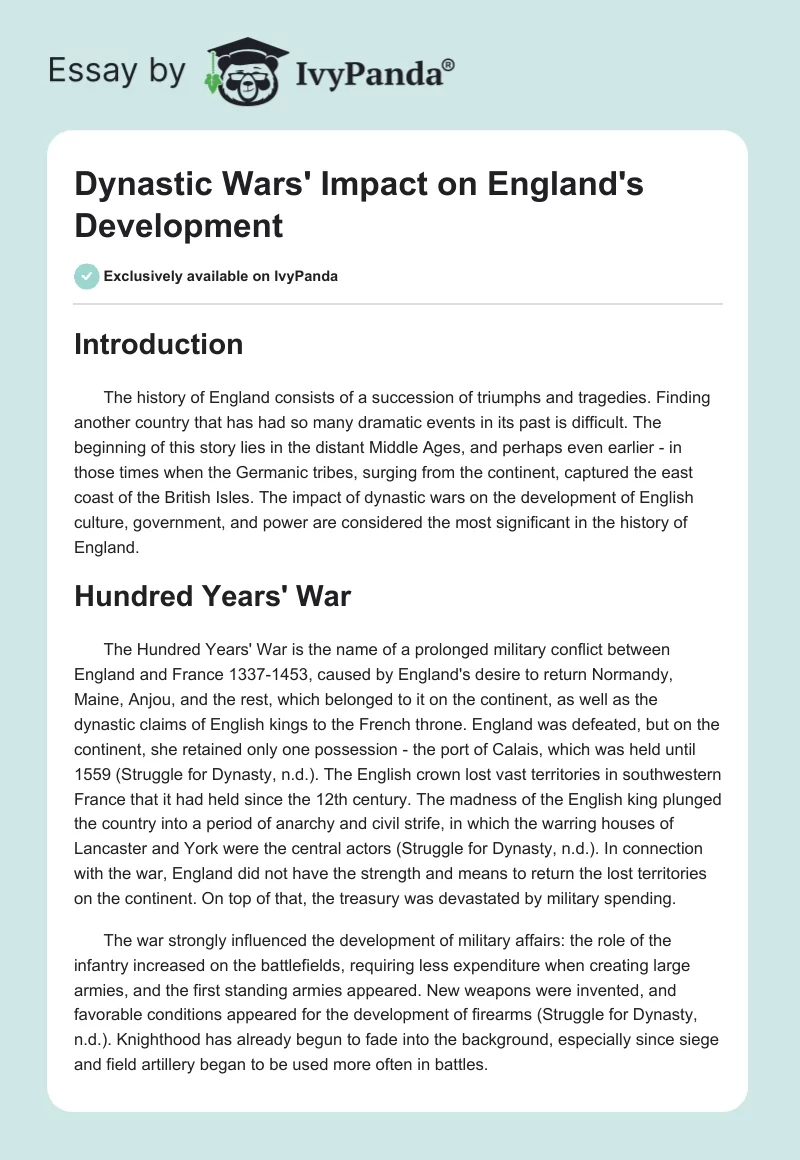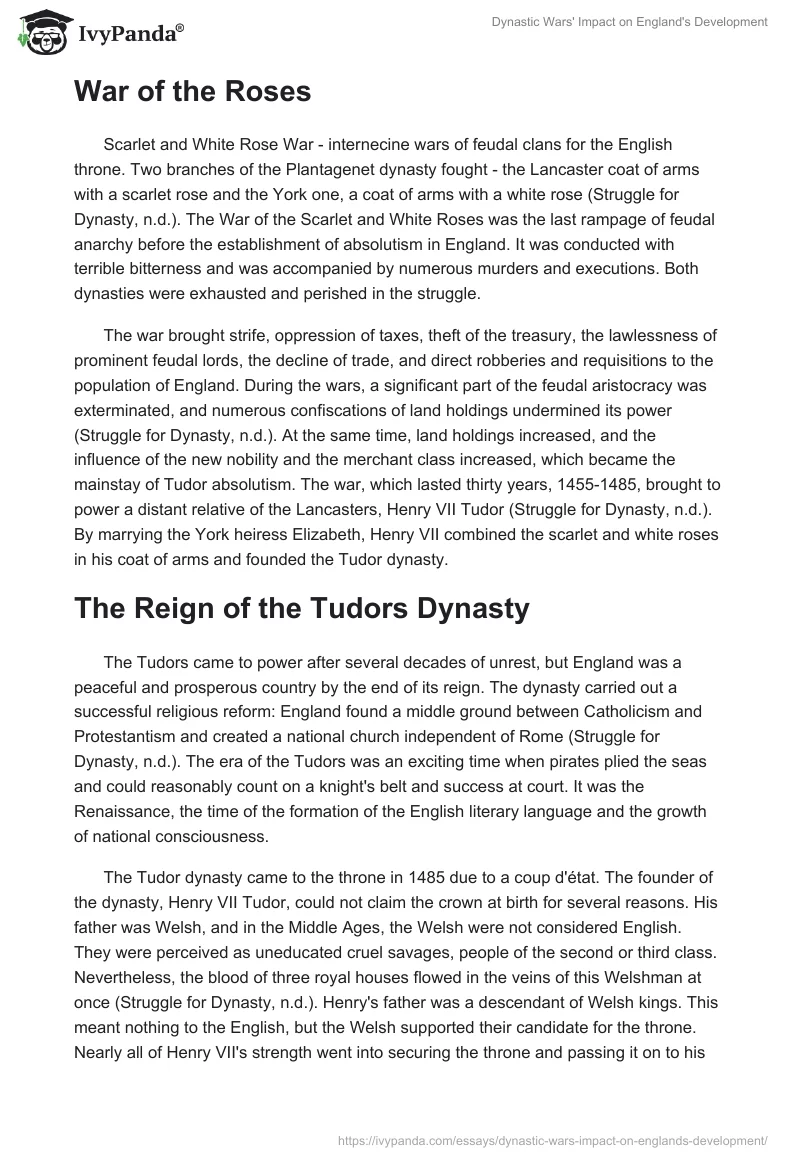Introduction
The history of England consists of a succession of triumphs and tragedies. Finding another country that has had so many dramatic events in its past is difficult. The beginning of this story lies in the distant Middle Ages, and perhaps even earlier – in those times when the Germanic tribes, surging from the continent, captured the east coast of the British Isles. The impact of dynastic wars on the development of English culture, government, and power are considered the most significant in the history of England.
Hundred Years’ War
The Hundred Years’ War is the name of a prolonged military conflict between England and France 1337-1453, caused by England’s desire to return Normandy, Maine, Anjou, and the rest, which belonged to it on the continent, as well as the dynastic claims of English kings to the French throne. England was defeated, but on the continent, she retained only one possession – the port of Calais, which was held until 1559 (Struggle for Dynasty, n.d.). The English crown lost vast territories in southwestern France that it had held since the 12th century. The madness of the English king plunged the country into a period of anarchy and civil strife, in which the warring houses of Lancaster and York were the central actors (Struggle for Dynasty, n.d.). In connection with the war, England did not have the strength and means to return the lost territories on the continent. On top of that, the treasury was devastated by military spending.
The war strongly influenced the development of military affairs: the role of the infantry increased on the battlefields, requiring less expenditure when creating large armies, and the first standing armies appeared. New weapons were invented, and favorable conditions appeared for the development of firearms (Struggle for Dynasty, n.d.). Knighthood has already begun to fade into the background, especially since siege and field artillery began to be used more often in battles.
War of the Roses
Scarlet and White Rose War – internecine wars of feudal clans for the English throne. Two branches of the Plantagenet dynasty fought – the Lancaster coat of arms with a scarlet rose and the York one, a coat of arms with a white rose (Struggle for Dynasty, n.d.). The War of the Scarlet and White Roses was the last rampage of feudal anarchy before the establishment of absolutism in England. It was conducted with terrible bitterness and was accompanied by numerous murders and executions. Both dynasties were exhausted and perished in the struggle.
The war brought strife, oppression of taxes, theft of the treasury, the lawlessness of prominent feudal lords, the decline of trade, and direct robberies and requisitions to the population of England. During the wars, a significant part of the feudal aristocracy was exterminated, and numerous confiscations of land holdings undermined its power (Struggle for Dynasty, n.d.). At the same time, land holdings increased, and the influence of the new nobility and the merchant class increased, which became the mainstay of Tudor absolutism. The war, which lasted thirty years, 1455-1485, brought to power a distant relative of the Lancasters, Henry VII Tudor (Struggle for Dynasty, n.d.). By marrying the York heiress Elizabeth, Henry VII combined the scarlet and white roses in his coat of arms and founded the Tudor dynasty.
The Reign of the Tudors Dynasty
The Tudors came to power after several decades of unrest, but England was a peaceful and prosperous country by the end of its reign. The dynasty carried out a successful religious reform: England found a middle ground between Catholicism and Protestantism and created a national church independent of Rome (Struggle for Dynasty, n.d.). The era of the Tudors was an exciting time when pirates plied the seas and could reasonably count on a knight’s belt and success at court. It was the Renaissance, the time of the formation of the English literary language and the growth of national consciousness.
The Tudor dynasty came to the throne in 1485 due to a coup d’état. The founder of the dynasty, Henry VII Tudor, could not claim the crown at birth for several reasons. His father was Welsh, and in the Middle Ages, the Welsh were not considered English. They were perceived as uneducated cruel savages, people of the second or third class. Nevertheless, the blood of three royal houses flowed in the veins of this Welshman at once (Struggle for Dynasty, n.d.). Henry’s father was a descendant of Welsh kings. This meant nothing to the English, but the Welsh supported their candidate for the throne. Nearly all of Henry VII’s strength went into securing the throne and passing it on to his son, Henry VIII, who reigned from 1509 to 1547 (Struggle for Dynasty, n.d.). He came to the throne at seventeen and appeared opposite his father. The new king was handsome and cheerful; he sang, composed poetry, and fought in tournaments.
Despite all diligence, Henry VIII failed to secure a prosperous future for the dynasty. As a result of the first marriage, Princess Mary was born. Anne Boleyn also gave birth to a daughter, Elizabeth (Struggle for Dynasty, n.d.). The third marriage gave Heinrich the long-awaited son – Edward, but the boy was frail and sickly. Before his death, the king established the following order of succession to the throne: Edward, Mary, and Elizabeth.
Edward VI reigned from 1547 to 1553; he died at sixteen and did not have time to prove himself as a politician. Then, until 1558, the eldest daughter of Henry VIII, Mary, occupied the throne (Struggle for Dynasty, n.d.). She tried to revive Catholicism and began repressions against Protestants. Some called her Mary the Catholic, while others called her the Bloody Mary. Maria married King Philip II of Spain, but this marriage was fruitless. In 1558, the throne passed to Anne Boleyn’s daughter, Elizabeth. Elizabeth ruled for 45 years, from 1558 to 1603 (Struggle for Dynasty, n.d.). She went down in history as Elizabeth the Great, and her reign became known as the Elizabethan era. Elizabeth I became the first queen to pursue a genuinely independent policy.
The queen managed not only to continue her father’s approach but also save England from the extreme manifestations of the Reformation and Counter-Reformation, thereby avoiding participation in the religious wars that tormented Europe. Spain was the main enemy of England: the countries were divided not only by faith but also by rivalry for trade routes. The reign of Elizabeth coincided with the rise of culture. The queen patronized the fine arts: poetry, music, and theatre. Elizabeth’s contemporaries were William Shakespeare and Christopher Marlowe. Elizabeth is considered one of the favorite queens of the British and remains an iconic figure in British history.
Conclusion
The Tudors left the historical scene peacefully and even casually. This fact was no small achievement because the rule of the three previous dynasties – Plantagenets, Lancasters, and Yorks – ended in coups and the assassination of monarchs. Childless Elizabeth I bequeathed the English throne to her cousin, King James IV of Scotland, who ascended the English throne under the name James I. This decision was the last success of the Tudor dynasty: England and Scotland, who had been at war for centuries, peacefully united based on a personal union. In conclusion, as shown above, each dynasty contributed to all aspects of England.
Reference
(n.d.). Struggle for Dynasty 1327-1603 [Video]. Web.


 3.50
3.50
